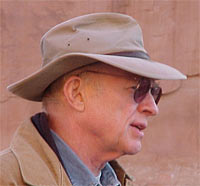Geologist Walter Alvarez receives top earth sciences award
| 20 October 2008
BERKELEY — Walter Alvarez, a University of California, Berkeley, geologist whose love of quarries and outcroppings led him to the startling conclusion that a meteor wiped out the dinosaurs 65 million years ago, has received the highest award in the field of earth sciences: the Vetlesen Prize.
 Walter Alvarez (Steve Dutch photo)
Walter Alvarez (Steve Dutch photo)"Research conducted and inspired by Walter Alvarez has changed the way we view the history of the Earth," the Vetlesen Prize committee's citation reads. "For more than a century, the dominant view of how Earth evolved was one of 'uniformitarianism' - a slow, gentle change caused by processes observable today. [His] work proved that major catastrophic events can shape the evolution of our planet."
Alvarez will receive the award and its accompanying medal from Columbia president Lee Bollinger at the university's Low Library on Nov. 21.
Alvarez was a young field geologist at UC Berkeley in the 1970s when, at a limestone outcrop near Gubbio, Italy, he noticed a thin layer of red clay that showed none of the tiny fossilized shells that dominated older rock layers. An analysis of the layer showed an abnormally large amount of iridium, a rare Earth element that is common in comets and asteroids.
Together with his father, the late Nobel Prize-winning physicist Luis Alvarez, and Lawrence Berkeley National Laboratory chemists Frank Asaro and Helen Michel, Walter Alvarez proposed in 1980 that sea creatures and many other forms of life were killed off in a global catastrophe that followed a comet or meteor impact 65 million years ago. The dinosaur became the poster child of this "mass extinction," but since then, scientists have proposed other extinction events corresponding to observed disappearances in the fossil record.
"Alvarez's research showed that life on earth is affected by how our planet interacts with the cosmos," said G. Michael Purdy, director of the Lamont-Doherty observatory. "He not only moved the study of extraterrestrial impacts from science fiction into the mainstream; he forever changed the way we view our world and its evolution."
The prize committee noted that, with cosmic impacts the frequent subject of books, movies and museum exhibits, Alvarez has succeeded in "bridging the scientific world and that of popular culture."
Alvarez told the story of his discovery in his 1997 book "T. Rex and the Crater of Doom," and is soon to publish a new book, "The Mountains of St. Francis," explaining how quarries have told about plate tectonics, the origins of Italy's Apennine Mountains and geology's influence on ancient Rome.
The award is funded by the New York-based G. Unger Vetlesen Foundation and administered by Lamont-Doherty Earth Observatory, a member of Columbia University's Earth Institute. The foundation was established in 1959 by the trustees of G. Unger Vetlesen, a Norwegian immigrant to the United States who became a leading shipbuilder, World War II military leader and pioneer in transatlantic air travel. Designed to recognize sweeping achievements on par with the Nobel Prize, which has no regular prize in earth sciences, it is given every several years by a jury appointed by the president of Columbia University.
For more information, link to the Lamont-Doherty press release.

